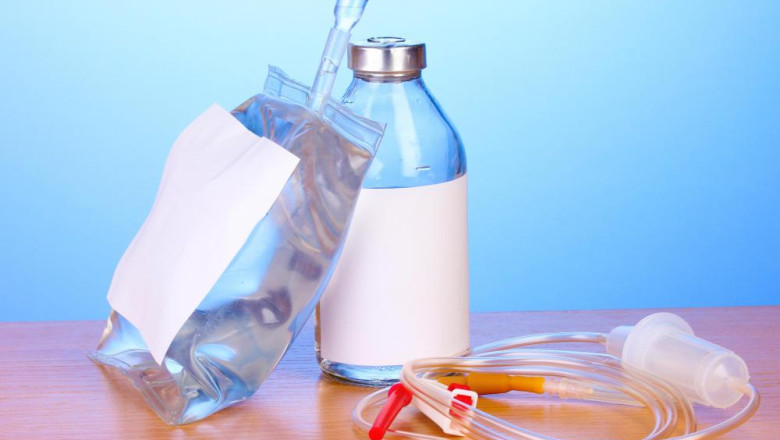views

Composition of IV Fluids
IV fluids, also known as intravenous solutions, are administered directly into a patient's bloodstream through an intravenous access device such as a catheter. The main components of IV solutions include water, electrolytes, sugars, and other compounds necessary to maintain fluid balance and blood circulation in the body. Let's examine the key ingredients found in intravenous solutions.
Water
Water makes up the bulk of IV fluids and serves as the delivery medium. Maintaining adequate hydration is essential for normal physiological functioning. Intravenous fluids contain purified water that has been processed to remove impurities and minerals.
Electrolytes
Electrolytes like sodium, potassium, magnesium, and calcium are dissolved in water to make up IV Intravenous Solutions. These charged mineral particles play vital roles like regulating fluid balance, nerve impulse transmission, and muscle contraction. Different types of IV fluids contain varying concentrations of electrolytes tailored to the patient's needs. For example, saline solutions contain higher amounts of sodium while potassium-containing bags replenish potassium levels.
Dextrose
Dextrose, or glucose, is commonly added to IV fluids to provide a source of carbohydrates and calories. Since glucose cannot readily cross cell membranes on its own, dextrose works to shuttle electrolytes into cells when administered intravenously. It also helps prevent hypoglycemia in patients who are NPO or have inadequate oral intake. 5% and 10% dextrose solutions are commonly available.
Other Additives
Beyond the key components above, IV fluids may also contain minor amounts of additives like:
- Acetic acid or sodium hydroxide to maintain the proper pH level and prevent fluid excessively acidifying or alkalizing the blood.
- Chloride ions to contribute to acid-base and fluid balance in conjunction with sodium.
- Calcium salts to prevent hypocalcemia in some cases.
- Vitamins, minerals, and trace elements to supplement nutrition if a patient requires long-term IV support.
Types of IV Fluids
Saline Solutions
Normal saline (0.9% sodium chloride) is the most widely used IV fluid. It contains electrolytes similar in concentration to plasma and thus does not disturb fluid/electrolyte balance when administered moderately. Half-normal saline contains 0.45% sodium chloride for milder rehydration needs.
Balanced Crystalloid Solutions
These contain an optimal sodium/potassium/chloride ratio along with other electrolytes like calcium, magnesium, acetate/lactate buffers. They mimic plasma composition closer than saline alone and reduce metabolic abnormalities. Common brands include Plasma-Lyte and Normosol-R.
Dextrose Solutions
As mentioned above, dextrose is added to IV fluids to provide calories and prevent hypoglycemia. Premixed concentrations of 5% and 10% dextrose in water are available. Dextrose may also be combined with saline or balanced crystalloids for more robust rehydration and nutrition support purposes.
Amino Acid Solutions
These IV fluids contain essential and non-essential amino acids, vitamins, trace elements, and carbohydrates. They provide nutrition for patients who cannot receive nutrition through regular means like the enteral route. Common brands are TrophAmine and Clinimix.
Lipid Emulsions
Lipid emulsions supply calories, essential fatty acids, and lipid soluble vitamins to patients requiring long-term IV nutrition. Examples are Liposyn, ClinOleic, and SMOFlipid. They are usually administered separately through a peripheral or central line.
Multichamber Bags
These combine various dextrose, electrolyte, amino acid, and/or lipid components in a single bag designed to fulfill most nutritional and fluid requirements through a single IV access. Ex: Clinimix E, SmofKabiven, Clinisol.
Indications for Intravenous Solutions
- Hypovolemia from excessive fluid losses due to vomiting, diarrhea, fever, burns, surgery etc. Saline restores fluid volume.
- Dehydration and electrolyte imbalances. Balanced fluids correct disturbances better than saline alone.
- Inability to maintain oral intake for medical reasons. Total parenteral nutrition prevents starvation.
- Severe illness with high caloric/nutrition needs. IV supplements enable faster recovery than oral route.
- Pre-/post-op management. IV ensures hydration during nil-by-mouth status and aids postsurgical recovery.
- Chronic intestinal failure. Home parenteral nutrition improves quality of life in such cases.
- Congestive heart failure. Restricted fluids require dilution and maintenance via IV route.
Careful monitoring of fluid balance, electrolyte levels, nutrition status helps administer IV solutions judiciously depending on clinical condition and goals of therapy. Precautions like proper line/site care minimize potential risks of IV therapy as well.
Get more insights on Intravenous Solutions




















Comments
0 comment